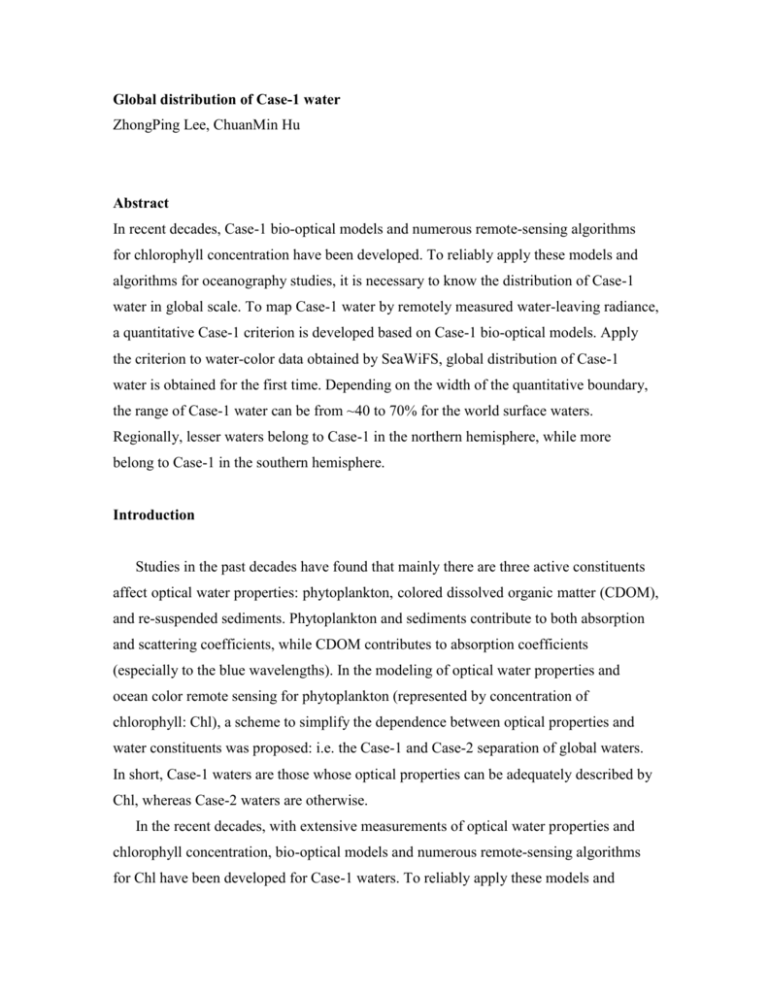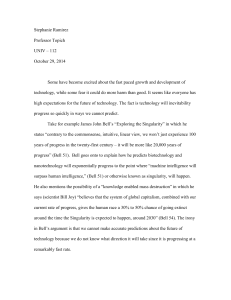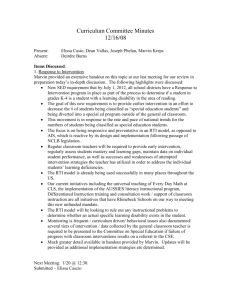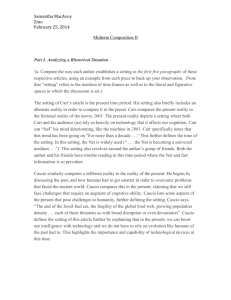Global distribution of Case-1 water and its seasonal variation
advertisement

Global distribution of Case-1 water ZhongPing Lee, ChuanMin Hu Abstract In recent decades, Case-1 bio-optical models and numerous remote-sensing algorithms for chlorophyll concentration have been developed. To reliably apply these models and algorithms for oceanography studies, it is necessary to know the distribution of Case-1 water in global scale. To map Case-1 water by remotely measured water-leaving radiance, a quantitative Case-1 criterion is developed based on Case-1 bio-optical models. Apply the criterion to water-color data obtained by SeaWiFS, global distribution of Case-1 water is obtained for the first time. Depending on the width of the quantitative boundary, the range of Case-1 water can be from ~40 to 70% for the world surface waters. Regionally, lesser waters belong to Case-1 in the northern hemisphere, while more belong to Case-1 in the southern hemisphere. Introduction Studies in the past decades have found that mainly there are three active constituents affect optical water properties: phytoplankton, colored dissolved organic matter (CDOM), and re-suspended sediments. Phytoplankton and sediments contribute to both absorption and scattering coefficients, while CDOM contributes to absorption coefficients (especially to the blue wavelengths). In the modeling of optical water properties and ocean color remote sensing for phytoplankton (represented by concentration of chlorophyll: Chl), a scheme to simplify the dependence between optical properties and water constituents was proposed: i.e. the Case-1 and Case-2 separation of global waters. In short, Case-1 waters are those whose optical properties can be adequately described by Chl, whereas Case-2 waters are otherwise. In the recent decades, with extensive measurements of optical water properties and chlorophyll concentration, bio-optical models and numerous remote-sensing algorithms for Chl have been developed for Case-1 waters. To reliably apply these models and algorithms for oceanography studies, it is necessary to know the global distribution of Case-1 water and its temporal variation. However, there is no geographic map of Case-1 water yet, except in common practice oceanic waters are assumed as Case-1 without rigorous scrutinizing. Case-1 is a concept to separate out optical simple waters from optically complex waters. Optically, if a water belongs to the Case-1 category, its optical properties can then be predicted solely from Chl. Apparently, classification of Case-1 is not based on the geographic location, nor based on the values of Chl. Water in the coastal region could be Case-1, where as water in the open ocean could be Case-2. Similarly, water with Chl as low as 0.05 mg/m3 could be Case-2, while water with Chl as high as 50 mg/m3 could really be Case-1. Clearly, the key to judge if a water belongs to Case-1 or not relies on the dependence between optical water properties (such as absorption, scattering, and backscattering coefficients) and Chl. Ideally, it requires concurrent measurements of both optical water properties and Chl to map the global distribution of Case-1 waters. Unfortunately, restricted by insufficient spatial and temporal coverage associated with traditional ship survey, such kind of approach is unrealistic to obtain high-resolution results for global coverage. A practical means to meet the desire of mapping the global distribution of Case-1 is to use ocean color data obtained from satellite sensors. In this study, based on the bio-optical models for Case-1 waters developed from recent and historical measurements, we devised a relaxed remote-sensing criterion for Case-1 waters. Further, we applied this criterion to the lately updated global ocean color measurements obtained by the SeaWiFS to analyze for the first time the global distribution of Case-1 waters and its seasonal variations. The results of this study provide a general guidance where Case-1 remote-sensing algorithms and bio-optical models could be applied. 2. Remote-sensing criterion for Case-1 water In ocean color remote sensing, the only available information is the water-leaving radiance (a quantitative measure of water color) measured by a remote sensor, along with some auxiliary information such as observation geometry, sea state, etc. Optical properties and Chl could be derived from water-leaving radiance with a remote-sensing algorithm. The derived optical properties and Chl values by such an approach, however, are associated with uncertainties (especially Chl), and many times different Chl could be obtained with different remote-sensing algorithms. These characteristics make it difficult to use remotely derived optical properties and Chl to map Case-1 waters. Also, for application of Case-1 remote-sensing algorithms and bio-optical models, a method to map Case-1 waters by water-leaving radiance is useful and desirable. Fundamentally, Case-1 waters are those whose optical properties can be determined by Chl. These optical properties include water’s inherent optical properties (such as absorption and scattering coefficients, etc) and apparent optical properties (such as remote-sensing reflectance, Rrs). Therefore, for case-1 waters, there is certain dependence among the Rrs values at different spectral bands. Note that Rrs is the ratio of water-leaving radiance to downwelling irradiance just above the surface (Ed). Since Ed can be adequately calculated with knowledge of atmospheric properties, Rrs is a quantity that directly measures water color. Consequently, for a water pixel with Rrs obtained from a satellite sensor, a comparison of its spectral dependence to the spectral dependence of Case-1 Rrs provides a measure if the water belongs to Case-1. From recent and historical measurements of Chl and optical properties, a relationship between Chl and Rrs for Case-1 water has been developed. Apply this Case-1 bio-optical model, for Chl values ranged from 0.02 to 30 mg/m3, Rrs at the SeaWiFS bands were calculated following the iterative steps described in Morel and Maritorena (2001). Further, the following spectral ratios are calculated: RR12 Rrs ( 412) R (555) , RR53 rs . Rrs ( 443) Rrs ( 490) (1) Here 412, 443, 490, and 555 are wavelengths in units of nm, and are the center wavelengths of SeaWiFS band 1, 2, 3, and 5, respectively. In ocean color remote sensing, RR53 is an indicator of Chl (e.g., the OC2 algorithm for SeaWiFS), while RR12 is an indicator of relative abundance of CDOM per Chl. For Case-1 waters, because CDOM co-varies with Chl, a monotonic line exists between RR12 and RR53, as shown in Figure 1 by the blue line. For most natural waters, because CDOM does not necessarily co-vary with Chl, wide variations of RR12 exist for the same RR53 values, as shown in Figure 1. To map the global distribution of Case-1 water, a quantitative boundary (though difficult and somewhat arbitrary) has to be drawn between Case-1 and non-Case-1 waters. For easier processing, we map Case-1 in such a manner: for a water pixel with values of CS 1 RR12 and RR53 from remote-sensing measurements, if its RR12 is between (1 ) RR12 and (1 ) RR12CS 1 , then we classify this water belongs to the Case-1 category. Otherwise, CS 1 it belongs to non-Case-1. Here RR12 is the Case-1 RR12 value that corresponding to the RR53 value of that pixel (the blue line in Fig.1). Clearly, the inclusiveness of Case-1 relies on the selection of the value of . Ideally, = 0 for “pure” Case-1 water. Practically, a none-zero value has to be used to account for imperfections from model to measurements. To be inclusive (though still arbitrary), we initially set as 0.05, i.e. to allow a 5% deviation of RR12 for the same RR53 value. Note that this 5% deviation implies a likely error of -30% ( = 5%) to 50% ( = -5%) in the prediction of aCDOM(443)/aChl(443) ratio for the same Chl. Here aCDOM(443) and aChl(443) are the absorption coefficients of CDOM and chlorophyll at 443 nm, respectively. For Case-1 waters, aCDOM(443)/aChl(443) ratio is a fixed value for given Chl as it solely depends on Chl. The error range of aCDOM(443)/aChl(443) thus indicates a loosely defined co-variation between the absorption coefficients of CDOM and Chl. It is necessary to point out that using the RR12 - RR53 relationship alone is a quite relaxed standard to classify Case-1 water, simply because this relationship to the most only evaluates if the optical property of CDOM co-varies with Chl as expected by Case-1 bio-optical models. Suspended sediments, a primary factor determines the magnitude of Rrs(λ) through its contribution to backscattering coefficient, is ignored here (will be discussed later). 3. Distribution of Case-1 water by the remote-sensing criterion To know the global distribution of Case-1 waters under the remote-sensing criterion devised above, the lately reprocessed SeaWiFS global data is acquired from GorDAD. Seasonally averaged normalized water-leaving radiance ([Lw(λ)]N) of the first five SeaWiFS bands collected between March 23, 2003 and March 23, 2004 were obtained. By definition of [Lw(λ)]N, Rrs(λ) of each pixel is the ratio of [Lw(λ)]N to F0(λ). Here F0(λ) is the solar irradiance on top of the atmosphere with a mean Sun-Earth distance and is available at GorDAD. From these Rrs(λ), RR12 and RR53 values of each pixel are then easily calculated. As an example, Figures 1a and 1b show the ranges and variations of RR12 and Rrs(555) for each RR53 value of the global surface waters, measured by SeaWiFS in the period of September 21, 2003 – December 20, 2003. The blue line in both figures indicates the Case-1 RR12 and Rrs(555) values that corresponding to the RR53 value, respectively. The cyan and green lines in Fig.1a indicate the 5% deviation of RR12 for the same RR53 value; whereas the cyan and green lines in Fig.1b indicate a 30% deviation of Rrs(555) for the same RR53 value. When RR53 is perceived as a measure of Chl (the numbers in the parenthesis), clearly, even for waters with Chl less than 1.0 mg/m3 (a range encompass most oceanic waters), there are quite wide variations in both RR12 and Rrs(555) for global waters. Apply the Case-1 remote-sensing criterion defined earlier, global water is separated into four categories as depicted in Fig.2. The cyan colored points are for pixels with RR12 values higher than the cyan line; the blue color for pixels (Case-1 water) with RR12 CS 1 CS 1 values between 0.95 RR12 and 1.05 RR12 ; the green color are for pixels with RR12 CS 1 values between 0.50 and 0.95 RR12 ; and the red color for pixels with RR12 values less than 0.50. Apply this separation to the global observation, a map of the four classifications are obtained (see Fig.3a-d for Spring, Summer, Fall, and Winter, respectively). Generally, by this Case-1 remote-sensing criterion, Case-1 (blue pixels) take ~40% of the global surface waters. Seasonally, there are more (46%) Case-1 in Fall, and less in Spring. There are more green pixels in Summer (a result of phytoplankton degradation bloomed in Spring), and less in Fall. Geographically, blue pixels (Case-1 water) are generally in the sub-tropic regions, whereas green pixels occupy mostly the northern hemisphere and coastal regions, with 90% of the cyan pixels around the equator. Red colored pixels only take about 1% of the global surface water, and are generally around coastal lines, likely a combination of incorrect atmospheric correction and enhanced CDOM concentrations. Recall that for each RR53 ratio (an index of Chl), the RR12 value is a relative measure of CDOM per Chl. Therefore cyan color indicates relatively lower CDOM for the same Chl compared to Case-1 water, while green color indicates relatively higher CDOM for the same Chl compared to Case-1 water. The global distribution of these colors suggesting that there are less CDOM in the tropical Pacific due to photo-bleaching, while more CDOM in coastal and northern waters, results of land run-off and productivity. Inversely, if the same empirical Case-1 algorithm for Chl (such as the OC2 SeaWiFS algorithm) is applied to the global waters, overestimation of Chl would be resulted to high latitude waters while underestimation to tropical waters, even without consideration of phytoplankton package effect. Clearly, the percentage of surface water that belongs to Case-1 depends on the width of the Case-1 boundaries. If we relax further the standard for Case-1 by selecting as 0.1 (a 10% deviation of RR12 for the same RR53 value), substantially more surface waters could be classified as Case-1 water. However, this 10% deviation of RR12 (centered on the Case-1bio-optical model predicted value) indicates a likely error of -46% ( = 10%) to 100% ( = -10%) in the ratio of aCDOM(443)/aChl(443) for the same Chl. Such kind of a range is then over-inclusive compared with the co-variation requirement between CDOM and Chl for Case-1 waters. Even with this significantly relaxed criterion (plus no consideration of Rrs values), Case-1 water takes about 70% of the global surface waters (see Figure 4 and Table 2). Again, tropical Pacific waters and high latitude northern hemisphere waters do not belong to such a broad Case-1 category. These results and distributions support further the argument the oceanic waters are not necessarily Case-1 water, and caution needs to taken when apply Case-1 bio-optical models and algorithms to global waters. Regionally, by this quantitative Case-1 remote-sensing criteria, the Mediterran and the Japan sea are hardly belong to Case-1 category, and both are in green color (meaning more 50% or more CDOM than predicted by the Case-1 model for the same Chl). 4. Summary In ocean color remote sensing, it is commonly assumed that oceanic waters belong to Case-1, while coastal waters belong to Case-2, though no clear boundary is drawn between oceanic and coastal waters. Further, numerous remote sensing algorithms have been developed for Case-1 water, but the distribution of Case-1 water in global scale is vague and elusive. To fill this gap, and to gain a clearer knowledge of the global Case-1 distribution, we developed a relaxed Case-1 remote-sensing criterion based on widely accepted Case-1 bio-optical models. Further, we applied this criterion to the lately updated global ocean color data collected by SeaWiFS to map the global distribution of Case-1 water. The results of such an exercise show that depending the inclusiveness (or boundary) of Case-1 definition, Case-1 water takes ~ 40-70 of the global surface waters, with most of them in the subtropical and the southern hemisphere. For the four seasons studies, there are apparent seasonal variations for some specific local regions, such as the north Atlantic, and the Indian Ocean. For waters in tropic Pacific, due to its lower CDOM per Chl compared with the Case-1 bio-optical models, they actually do not belong to the Case-1 water defined quantitatively. Table 1. Global coverage of different water classes when is set as 0.05 Water class Spring Summer Fall Winter Cyan 31% 24% 32% 34% Blue (Case-1) 36% 41% 46% 40% Green 32% 34% 21% 25% Red 1% 1% 1% 1% Table 2. Global coverage of different water classes when is set as 0.1 Water class Spring Summer Fall Winter Cyan 12% 10% 12% 12% Blue (Case-1) 65% 66% 73% 71% Green 22% 23% 14% 16% Red 1% 1% 1% 1%





